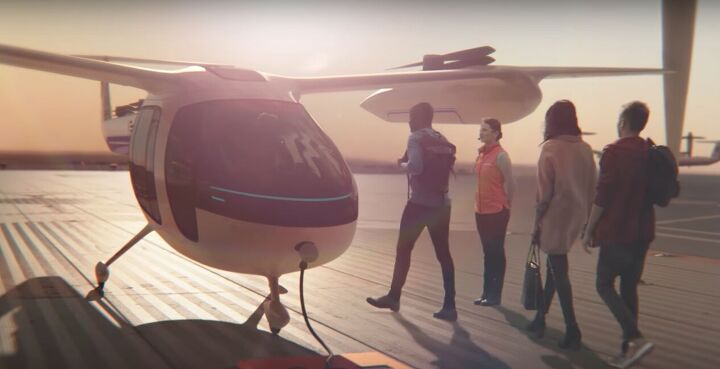North American Skies Will Be Filled With Flying Cars in 10 Years: Uber CEO

Uber Technologies Inc.’s chief executive, Dara Khosrowshahi, predicts a nearish future where civilians whiz around in sky-bound automobiles.
“There will be people flying around Dallas, Texas,” Khosrowshahi said at the Digital Life Design conference in Munich, his first work-related appearance in Europe since taking over as Uber’s CEO last year. “I think it’s going to happen within the next ten years.”
Considering we’ve been waiting on flying cars for roughly 100 years, what’s another decade?
We’re kidding, of course. Anyone with a modicum of common sense understands that mass-produced floating automobiles are pure fantasy. Work on such vehicles hasn’t really progressed all that swiftly and there’s been no breakthroughs in the technology, either. The best anyone seems to be able to do is build massive drones ( which crash) or automobiles that can be converted into airplanes.
Does that make Khosrowshahi a bearded liar?
Since the Bloomberg article doesn’t elaborate further on his claim and Uber isn’t ready to detail its flying car strategy, it’s difficult to say (but he does have a beard). As a CEO, Khosrowshahi will probably make a lot of outrageous claims illustrating the role his company will play in a hypothetical futuristic utopia — exciting investors with total nonsense is a big part of the job.
However, we’d argue that anyone focusing seriously on air-based vehicles that will ultimately replace the automobile is a bit of a crackpot. Automakers have had numerous opportunities to slap a set of tires on a helicopter, but nobody has bothered with it. Flying cars aren’t a thing, and they definitely aren’t “going to happen within the next ten years.” Fully autonomous cars may not even be 10 years away — and even if they are, they won’t be ubiquitous by then.
The company does have sky-high aspirations, though. Last year, Uber partnered with NASA to develop novel traffic concepts that could be used for robotic flight systems. By working with aircraft, infrastructure and real estate partners, Uber thinks it can undercut traditional aircraft companies by setting up a high-speed flight network with fixed routes between major hubs. The company is called “uberAir” and would work exactly like Uber only with fixed pickup and drop-off points conducive to flying.
The company has also hinted at using flying drones as part of the food-delivery service Uber Eats. As a sack of hamburgers is lighter and less important than a human being, the company incurs less risk when it falls from the sky and explodes all over the pavement. Likewise, getting an email saying your food failed to arrive is easier to cope with than “your wife could not be delivered due to technical limitations of our new service.”
So far as we know, Uber isn’t planning on flying people anywhere using small delivery drones — but it did push Uber Elevate last fall. Elevate was a hypothetical side business that sounds exactly like uberAir. In fact, head of product Jeff Holden actually said the aerial taxi service would start in Dallas by 2020. But these aren’t exactly flying cars, as Khosrowshahi suggested, they’re helicopters that Uber says should also probably be electric and autonomous.
Even without a working prototype of the vehicle, Holden claims Uber’s Elevate/Air program is just around the corner.
“There’s been a great deal of progress that’s been hard to see from the outside, because a lot of this is just hard work at the drafting table,” he said in a 2017 interview with The Verge. “We feel really good. It’s been a really interesting process getting our vehicle manufacturing partners aligned on performance specifications, so that they’re building vehicles that align with what we need to make Elevate successful. So lots of good progress there.”
That’s a relief, as we were starting to think this was all made-up bullshit designed to make the company look good.
[Image: Uber Technologies Inc.]

A staunch consumer advocate tracking industry trends and regulation. Before joining TTAC, Matt spent a decade working for marketing and research firms based in NYC. Clients included several of the world’s largest automakers, global tire brands, and aftermarket part suppliers. Dissatisfied with the corporate world and resentful of having to wear suits everyday, he pivoted to writing about cars. Since then, that man has become an ardent supporter of the right-to-repair movement, been interviewed on the auto industry by national radio broadcasts, driven more rental cars than anyone ever should, participated in amateur rallying events, and received the requisite minimum training as sanctioned by the SCCA. Handy with a wrench, Matt grew up surrounded by Detroit auto workers and managed to get a pizza delivery job before he was legally eligible. He later found himself driving box trucks through Manhattan, guaranteeing future sympathy for actual truckers. He continues to conduct research pertaining to the automotive sector as an independent contractor and has since moved back to his native Michigan, closer to where the cars are born. A contrarian, Matt claims to prefer understeer — stating that front and all-wheel drive vehicles cater best to his driving style.
More by Matt Posky
Latest Car Reviews
Read moreLatest Product Reviews
Read moreRecent Comments
- ToolGuy If these guys opened a hotel outside Cincinnati I would go there to sleep, and to dream.
- ToolGuy Michelin's price increases mean that my relationship with them as a customer is not sustainable. 🙁
- Kwik_Shift_Pro4X I wonder if Fiat would pull off old world Italian charm full of well intentioned stereotypes.
- Chelsea I actually used to work for this guy
- SaulTigh Saw my first Cybertruck last weekend. Looked like a kit car...not an even panel to be seen.


































Comments
Join the conversation
As many lawsuits as Uber has going on against them right now this is just what they need.
Cocaine is a hell of a drug.